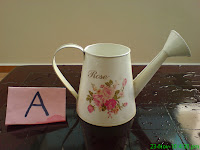Learning Outcomes :
· To measure volumes of liquid using non-standard units.
Materials:
· 3 types of watering can which consists of 3 different sizes.
· A Jug of water
· Various type of container which consist of different shapes and sizes.
Procedures:
1. Divide the class into groups of four students and have them work in their cooperative groups.
2. Appoint one student in the group to be the recorder.
3. Give each group a set of watering can of different sizes and a jug of water.
4. Student are ask to find out the which watering can can holds more water and which watering can hold the least water.
5. Student are given various containers that consist of different sizes and shapes to choose, they must only choose 3 containers to measure the water in the watering can correctly.
6. After 3 container had been choosen, student will have to fill each watering can with the jug of water given.
7. Then student will empty each watering can’s water into respective container that they had choosen.


8. Student will make conclusion on the capacity of each watering can as below:
Watering Can _______ had the biggest capacity.
Watering Can _______ had the least capacity.
9. Measure the volumes of liquid in container A, B and C in millilitres and litres.
Watering Can A has _________ millilitres of waters.
Watering Can B has _________ millilitres of waters.
Watering Can C has _________ millilitres of waters.
10. Instruct the students to arrange the three containers in descending order of their capacities.






































